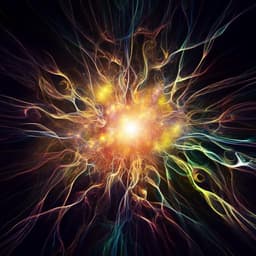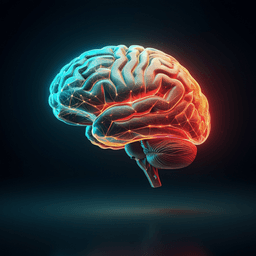
Psychology
Neural dynamics of the attentional blink revealed by encoding orientation selectivity during rapid visual presentation
M. F. Tang, L. Ford, et al.
Dive into the intriguing world of the attentional blink (AB) with research conducted by Matthew F. Tang, Lucy Ford, Ehsan Arabzadeh, James T. Enns, Troy A.W. Visser, and Jason B. Mattingley. This study uncovers the neural mechanisms behind why we sometimes miss crucial visual information, revealing the complex interactions between competing visual representations. Discover how feature selectivity impacts our perception during fast-paced visual tasks!
~3 min • Beginner • English
Introduction
The study investigates the neural dynamics underlying the attentional blink (AB), a phenomenon in which perception of a second target (T2) is impaired when it appears within roughly 200–500 ms after a first target (T1) in a rapid serial visual presentation (RSVP). The authors aim to overcome temporal resolution limitations of conventional neuroimaging by applying multivariate forward encoding to EEG to recover orientation-selective information for each rapidly presented item. Two central questions guide the work: (1) does focused temporal attention alter the gain (amplitude) or the precision (tuning width) of feature-selective neural representations? and (2) is T2 accuracy primarily determined by processing of T1 (T1-based accounts) or by processing of intervening distractors (distractor-based accounts)? The work has significance for theories of temporal attention and consciousness, including global workspace accounts, by clarifying whether AB reflects discrete access failures or graded degradation of sensory representations.
Literature Review
Prior work has established behavioral hallmarks of the AB and proposed multiple mechanisms, including T1-based capacity/dwell-time limits and distractor-based loss of input control. Lag-1 sparing and Lag-1 switching indicate potential temporal integration of successive targets. EEG/ERP studies have associated AB with reduced late-stage components linked to consolidation, while earlier sensory suppression has been less clear. Forward/inverted encoding models have successfully reconstructed feature-selective representations (e.g., orientation, color, spatial) from fMRI/MEG/EEG, and attention is known to modulate neural gain more than tuning width for spatial attention, whereas feature-based attention can affect tuning sharpness. Competing AB theories predict distinct neural signatures: T1-based accounts predict target-specific modulation (enhancement or suppression of T2), while distractor-based accounts predict strengthened distractor representations during the blink. Previous behavioral work also highlights masking by the immediately post-target item and limited influence from more distant distractors.
Methodology
Two experiments used an RSVP orientation reproduction paradigm with Gabors. Experiment 1 (N=22) measured behavior; Experiment 2 (N=23) measured concurrent EEG.
Stimuli and task: Trials comprised 20 centrally presented Gabor gratings (each 40 ms on, 80 ms blank; 8.33 Hz). Targets were high spatial frequency (2 c/°) and distractors low spatial frequency (1 c/°). Orientations (0–179°) were independently randomized without replacement per stream; T1 and T2 orientations were uncorrelated and non-identical. Between 4–8 distractors preceded T1 to reduce expectancy. Inter-target lags: Experiment 1 used lags 1,2,3,5,7; Experiment 2 used lags 3 and 7. Participants reproduced T1 and T2 orientations using a continuous report dial after the stream, in order, with accuracy emphasized; feedback was provided.
Behavioral analyses: Orientation errors (reported minus presented) were binned and fit with Gaussian plus constant offset G(x)=A exp(-(x-μ)^2/2σ^2)+C to estimate gain (A), width (σ), center (μ), and baseline (C; guessing). Regression analyses aligned items relative to targets (−4 to +7) to quantify the influence of each item (targets and distractors) on reported orientations using complex-valued linear regression to respect circularity. To assess integration biases, the difference between a target and another item’s orientation was related to orientation error, and first-derivative of Gaussian (D1) functions were fit to quantify orientation-tuned bias magnitude across lags and item positions.
EEG acquisition and preprocessing (Experiment 2): 64-channel BioSemi ActiveTwo, 1024 Hz (downsampled to 512 Hz), 0.5 Hz high-pass, line noise removal, bad channel repair via ASR, re-referenced to average, epoched (−0.5 s to 3.0 s relative to first Gabor), ICA-based artifact removal (SASICA), baseline correction (−500 to 0 ms).
Forward encoding modeling: Constructed a 9-channel orientation basis (half-cosine^8 functions centered 0–160° in 20° steps). Estimated sensor weights via least-squares with shrinkage/regularization to remove sensor noise correlations; applied cross-validated decoding to reconstruct 180-point orientation representations per time point. Initial analysis used 20 separate models (600 trials each) to verify recoverability per item; main analyses stacked all items across trials (12,000 item-epochs; 600 trials × 20 items) and aligned reconstructions to each item’s onset. Feature selectivity quantified by fitting Gaussians to orientation reconstructions over time; key window 100–150 ms after item onset.
Trial categorization: For EEG analyses, only trials with correct T1 reports were included; T2 trials were labeled correct if |error|<30° and incorrect otherwise, yielding roughly equal bins at Lag 3. Additional analyses binned T2 by absolute error in 15° steps.
Univariate topography: A GLM per sensor estimated orientation selectivity using sine and cosine regressors; scalp maps compared targets vs distractors using cluster-based permutation.
Statistics: Two-way and three-way repeated-measures ANOVAs for behavioral parameters and biases; Bonferroni-corrected t-tests for planned comparisons; sign-flipping cluster permutation tests for time-resolved EEG effects; cluster-based permutation for topographies.
Key Findings
Behavior (Experiment 1):
- Classic AB: T2 accuracy degraded at Lags 2–3, with both T1 and T2 degraded at Lag 1, and recovery at Lags 5–7.
- Gaussian fits showed T2 deficits at Lags 2–3 were primarily reductions in gain, not increases in width (precision). ANOVA: gain affected by Target (F(1,21)=10.00, p=0.005, ηp²=0.32), Lag (F(4,84)=11.66, p<0.0001, ηp²=0.36), and interaction (F(4,84)=7.10, p<0.0001, ηp²=0.25). Width not affected by Target, Lag, or interaction (all ps≥0.70). Baseline (guessing) increased for T2 at short lags (significant Target, Lag, and interaction).
- Item influence regression: Reported target orientations were driven by the corresponding target; at Lag 1, strong cross-target influence (Lag-1 switching). At Lags 2–3, T2 reports were significantly influenced by T1, while T1 reports were only marginally influenced by T2; distractors showed no reliable influence overall.
- Long-range integration: Orientation-tuned biases showed targets biased toward each other’s orientation at early lags, strongest at Lag 1 but significant at Lags 2–3 as well. D1 fits: main effects of Target (F(1,21)=5.04, p=0.04, ηp²=0.19), Lag (F(4,84)=6.54, p<0.0001, ηp²=0.24), and interaction (F(4,84)=6.14, p<0.0001, ηp²=0.27). T1 bias >0 at all lags; T2 bias significant at Lags 2–3.
- Post-target distractor bias: The immediately following distractor biased perceived orientation of the target (significant three-way interaction Target×Lag×Item position: F(16,336)=4.11, p<0.0001, ηp²=0.16); other distractors had little effect.
Behavior (Experiment 2):
- Replicated AB pattern at Lags 3 vs 7. ANOVA on correctness (with correct T1 only): main effects of Lag (F(1,22)=19.05, p<0.0001, ηp²=0.46), Target (F(1,22)=18.00, p<0.0001, ηp²=0.45), and interaction (F(1,22)=31.91, p<0.0001, ηp²=0.59). T2 accuracy lower at Lag 3 than Lag 7 (t(22)=5.20, p=0.0001), and lower than T1 at Lag 3 (t(22)=5.94, p<0.0001). Gaussian fits again showed gain and baseline differences but not width differences.
EEG forward encoding (Experiment 2):
- Orientation selectivity for each RSVP item emerged ~74 ms after onset and lasted to ~398 ms; successive items evoked overlapping impulse-like selectivity responses (~300 ms duration each).
- AB effect on T2: At Lag 3, T2 feature selectivity (gain) was significantly reduced for incorrect vs correct trials shortly after onset (100–150 ms; cluster p=0.02), while width, center, and baseline showed no AB effect. No differences at Lag 7.
- Time-averaged tuning (100–150 ms): For T2 at Lag 3, gain was higher on correct vs incorrect trials (t(22)=3.12, p=0.01, d=0.65); width unchanged (t(22)=1.66, p=0.11). At Lag 7, neither gain nor width differed by accuracy.
- Graded relationship with error: T2 Lag 3 feature selectivity decreased as report error increased (one-way RM ANOVA: F(1,22)=2.76, p=0.02, ηp²=0.11), indicating lower gain associated with larger errors and increased guessing.
Targets vs distractors (Experiment 2):
- On correct trials, both T1 and T2 evoked higher feature selectivity (gain) than adjacent distractors (all ps<0.04).
- On incorrect trials, T2 representations were significantly lower than adjacent distractors (t(22)=2.09, p=0.04, d=0.44), indicating suppression of T2 while distractors remained unaffected. Distractors before T1 vs during AB (between T1 and T2) did not differ in representation for correct (t(22)=0.85, p=0.40) or incorrect (t(22)=1.83, p=0.08) trials.
Topography:
- Orientation selectivity localized predominantly over occipital and parietal sensors. Targets elicited greater selectivity than distractors over these regions (cluster-based permutation significant differences).
Discussion
The findings directly address the study’s questions. First, temporal attention during the AB modulates the gain of feature-selective neural representations without altering their tuning width: T2 suppression at 100–150 ms after onset in AB (Lag 3) trials reduces representation strength but not precision, and successful T2 reports correspond to boosted gain relative to distractors. This pattern parallels effects of spatial attention on neural gain and argues against models positing reduced precision during the AB. Second, T2 failures are linked to target-target competition rather than enhanced distractor processing: target representations are boosted on accurate trials, while missed T2s are selectively suppressed below distractor levels; distractor representations are stable and not enhanced during the blink. These results favor T1-based accounts of the AB (extended processing/dwell time for T1 limiting access of T2) and are inconsistent with distractor-based loss-of-control theories.
Behaviorally, orientation reports exhibit temporal integration: targets bias each other’s perceived orientations not only at Lag 1 (Lag-1 switching) but also at Lags 2–3, and the immediate post-target distractor biases perception, highlighting both local (target with next item) and longer-range (target-target) integration within RSVP streams. The early T2 suppression suggests that ongoing T1 processing triggers inhibition of early sensory responses to T2, likely reducing its impact on later consolidation stages, consistent with prior ERP findings of diminished late components during the AB. Together, the data support a discrete access model in which items either achieve a boosted representation leading to accurate report or are suppressed leading to guessing, aligning with global workspace perspectives on conscious access.
Conclusion
This work introduces a forward-encoding EEG approach capable of recovering feature-selective representations for every item in a rapid visual stream, enabling precise characterization of neural dynamics during the attentional blink. The main contributions are: (1) demonstrating that AB-related deficits reflect reduced gain, not reduced precision, of T2’s feature-selective representation; (2) showing that distractor representations are not enhanced during the AB, supporting T1-based accounts; and (3) revealing unexpected long-range integration between targets separated by multiple intervening items. Future research should combine this methodology with high-spatial-resolution imaging (e.g., fMRI) or invasive recordings to localize neural sources and delineate feedforward vs feedback contributions, and extend the approach to related phenomena such as repetition blindness and contingent attentional capture.
Limitations
The study was not designed to localize the precise neural sources of AB-related effects; EEG’s limited spatial resolution constrains anatomical inference. In Experiment 2, EEG analyses focused on Lags 3 and 7 only, which may limit characterization across the full lag spectrum. Trial categorization into correct/incorrect using a 30° threshold, while validated by additional analyses, imposes a dichotomy on a continuous measure. The paradigm involves specific Gabor stimuli and RSVP parameters, which may affect generalizability to other stimulus types or tasks.
Related Publications
Explore these studies to deepen your understanding of the subject.







